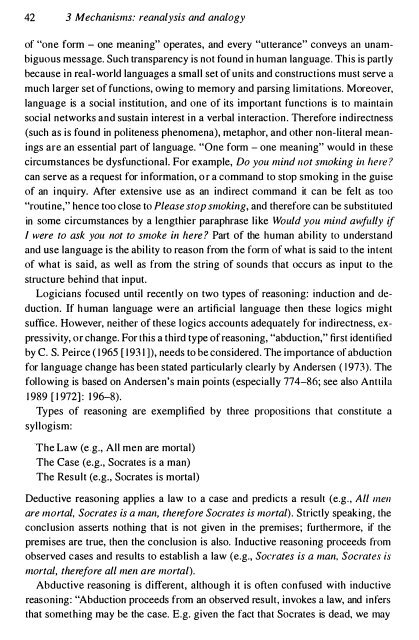Gram - SEAS
Gram - SEAS
Gram - SEAS
You also want an ePaper? Increase the reach of your titles
YUMPU automatically turns print PDFs into web optimized ePapers that Google loves.
42 3 Mechanisms: reanalysis and analogy<br />
of "one form - one meaning" operates, and every "utterance" conveys an unambiguous<br />
message. Such transparency is not found in human language. This is partly<br />
because in real-world languages a small set of units and constructions must serve a<br />
much larger set offunctions, owing to memory and parsing limitations. Moreover,<br />
language is a social institution, and one of its important functions is to maintain<br />
social networks and sustain interest in a verbal interaction. Therefore indirectness<br />
(such as is found in politeness phenomena), metaphor, and other non-literal meanings<br />
are an essential part of language. "One form - one meaning" would in these<br />
circumstances be dysfunctional. For example, Do you mind not smoking in here?<br />
can serve as a request for information, or a command to stop smoking in the guise<br />
of an inquiry. After extensive use as an indirect command it can be felt as too<br />
"routine," hence too close to Please stop smoking, and therefore can be substituted<br />
in some circumstances by a lengthier paraphrase like Wo uld you mind awfu lly if<br />
I were to ask you not to smoke in here? Part of the human ability to understand<br />
and use language is the ability to reason from the form of what is said to the intent<br />
of what is said, as well as from the string of sounds that occurs as input .[0 the<br />
structure behind that input.<br />
Logicians focused until recently on two types of reasoning: induction and deduction.<br />
If human language were an artificial language then these logics might<br />
suffice. However, neither of these logics accounts adequately for indirectness, expressivity,<br />
or change. For this a third type of reasoning, "abduction," first identilied<br />
by C. S. Peirce (1965 [193 1 )), needs to be considered. The importance of abduction<br />
for language change has been stated particularly clearly by Andersen ( 1973). The<br />
following is based on Andersen's main points (especially 774-86; see also Anttila<br />
1989 [1972]: 196-8).<br />
Ty pes of reasoning are exemplified by three propositions that constitute a<br />
syllogism:<br />
The Law (e.g., All men are mortal)<br />
The Case (e.g., Socrates is a man)<br />
The Result (e.g., Socrates is mortal)<br />
Deductive reasoning applies a law to a case and predicts a result (e.g., All men<br />
are mortal, Socrates is a mall, therefo re Socrates is mortal). Strictly speaking, the<br />
conclusion asserts nothing that is not given in the premises; furthermore, if the<br />
premises are true, then the conclusion is also. Inductive reasoning proceeds from<br />
observed cases and results to establish a law (e.g., Socrates is a man, Socrates is<br />
mortal, therefo re all men are mortal).<br />
Abductive reasoning is different, although it is often confused with inductive<br />
reasoning: "Abduction proceeds from an observed result, invokes a law, and infers<br />
that something may be the case. E.g. given the fact that Socrates is dead, we may
















